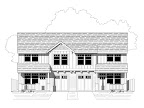Tuesday, December 29, 2015
Efficiency by Design - Roofs
After all the work of optimizing the rest of the house, you might think we could call it a day and cap our house. But wait, there's more! Efficiency by Design is a thorough study of EVERY part of the house. Why stop early when there's still a roof?
There are two main ways to build a roof. Historically one would use framing much like the walls and floors. The ceiling might be built of 2x4 or 2x6 to hold the ceiling finish while the rafters are 2x8 or 2x10. Sometimes beams are needed to support rafters, other times collar ties will suffice. It seems much more acceptable to install roof members at 24" o.c. when possible than it does other parts of the house.
A newer and sometimes cheaper and quicker way of building a roof is to use a truss. A truss is a pre-manufactured building component that has been engineered and optimized for its intended purpose. They are routinely designed to be used at 24" o.c. There are so many styles of trusses that a study on them and their techniques could be another blog series altogether.
And sometimes it's possible to mash up the two techniques. Part of a house may be trussed while another part is stick-framed to achieve ceiling designs that would be more costly or difficult in a truss. Even when a ridge changes direction, there is some minor overframing that is often stick built over one truss or another.
On some stick framed jobs you may find that installing a ridge beam puts a large point load where you would rather not have it. Specifying collar ties can eliminate the need for the beam as you are essentially creating an on site truss. Each rafter then becomes it's own load and shear resistant member. The collar ties don't have to rest at the top plate either. In many cases they can be elevated to enjoy a vaulted ceiling. You're likely installing ceiling joists anyway, why not have them be calculated as doing the structural work that they are likely doing?
The pitch of your roof can also be optimized. It is no more difficult for a truss manufacturer to create a 6.87:12 pitch roof than it is a 6:12 or 7:12. Why does this matter? What if the roof plane at 7:12 is 16'-5" from bird block to ridge? Your framer will now be trimming a 5" strip of sheathing to fill the gap unless you are planning on a ridge vent. Now it's a 3" strip.
But if you can reduce the pitch slightly you'll eliminate the need to involve extra labor for that little strip. Plus, the pitch will be dropped or raised so slightly that the change in aesthetic will barely be noticed, if at all. Of course there may be multiple runs of the same pitch so they should be best optimized for the longest run and possibly even take the other runs into account as well.
With trussed roofs there are a few ideas to consider. Have you or your designer ever considered the extra cost of the truss based on it's size? Anything with a dimension over 8'-6" requires an additional transportation permit. This is fairly common. But exceeding 14' with any truss dimension suddenly kicks in extra hardware or piggyback trusses. If your truss is 14'-4" then drop the pitch a little until it's at 13'-11".
Some roofs have so much dead space in them that it is a waste to leave it as attic. The living space that could be acquired is cheap square footage. You may not be interested in finishing it and that's okay. But installing attic or bonus room trusses with future access planned (or stairs and an insulated door already built in) gives your buyer the option to add space down the road.
These techniques are not difficult. We have spent years testing and honing them to find out what works and doesn't. Simply begin the conversation with an email or phone call. We'll handle the rest.
Subscribe to:
Post Comments (Atom)







No comments:
Post a Comment